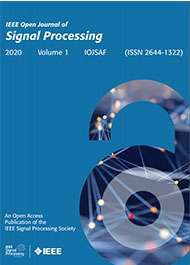Information for Authors OJSP
Top Reasons to Join SPS Today!
1. IEEE Signal Processing Magazine
2. Signal Processing Digital Library*
3. Inside Signal Processing Newsletter
4. SPS Resource Center
5. Career advancement & recognition
6. Discounts on conferences and publications
7. Professional networking
8. Communities for students, young professionals, and women
9. Volunteer opportunities
10. Coming soon! PDH/CEU credits
Click here to learn more.
Information for Authors OJSP
Aims & Scope
The IEEE Open Journal of Signal Processing covers the enabling technology for the generation, transformation, extraction, and interpretation of information. It comprises the theory, algorithms with associated architectures and implementations, and applications related to processing information contained in many different formats broadly designated as signals. Signal processing uses mathematical, statistical, computational, heuristic, and/or linguistic representations, formalisms, modeling techniques and algorithms for generating, transforming, transmitting, and learning from signals.
Open Access
This journal is 100% open access, which means that all content is freely available without charge to users or their institutions. All articles are currently published under Creative Commons licenses (either CCBY or CCBY-NC-ND), and the author retains copyright. Users are allowed to read, download, copy, distribute, print, search, or link to the full texts of the articles published under CCBY, or use them for any other lawful purpose, as long as proper attribution is given. Articles published under CCBY-NC-ND are also available to users under the same conditions as CCBY, but the reuse cannot be for commercial purposes or change the work in any way.
Open access is provided through the payment of an article processing charge (APC) paid after acceptance. APCs are often financed by an author's institution or the funder supporting their research. For specific information regarding APCs, please see "Article Processing Charges (APCs)" section below.
The articles in this journal are peer reviewed in accordance with the requirements set forth in the IEEE PSPB Operations Manual (sections 8.2.1.C & 8.2.2.A). Each published article was reviewed by a minimum of two independent reviewers using a single-blind peer review process, where the identities of the reviewers are not known to the authors, but the reviewers know the identities of the authors. Articles will be screened for plagiarism before acceptance.
Corresponding authors from low income countries are eligible for waived or reduced APCs.
Article Processing Charges (APC)
For accepted articles submitted between 1 January and 31 December 2025, the article processing charge (APC) for OJ-SP will be $1795 and cannot be combined with any other discounts.
Ethics
All IEEE authors are expected to adhere to IEEE’s publishing ethics, including the definition of authorship, the appropriate citation of sources, the accurate reporting of data, and the publishing of original research. Visit the IEEE Author Center to learn more. All articles submitted for publication should be original and not under consideration elsewhere; if your article is based on a previous publication such as a conference proceeding, cite the original publication and clearly indicate how the articles differ. Contact the Editor-in-Chief with any questions on publishing ethics.
Article Submission
Manuscripts should be formatted using the OJ-SP article template, located in the IEEE Author Center, and submitted in PDF format via our submission site, IEEE Author Portal. Manuscript preparation guidelines, including information on writing the abstract, using equations in your article, publishing author names in native languages, etc. can also be found in the IEEE Author Center. To align with principles of Open Science and Reproducibility, the Open Journal of Signal Processing (OJSP), requires authors of learning-based methods (e.g. Deep Learning and Dictionary Learning) to provide trained models along with software for validation. Please see the associated requirements on the “Reproducibility” page.
Submission types
Regular papers: Unlike other SPS journals, there is no hard limit on the page length of submissions. A length of 15 or fewer pages is recommended, but longer manuscripts are allowed when appropriate. There are no overlength page charges. Manuscripts submitted within this category will be reviewed for novelty, correctness, as well as for significance of the technical contribution.
Short papers: This paper type has a maximum length of 8 pages plus an additional page for references. (At the discretion of the Associate Editor, an additional page may be allowed after the initial review.) Unlike regular papers, author biographies are not included, and only multimedia supplemental material is permitted (i.e. no additional text). Due to the length limit, review should typically be faster than regular papers. Review of manuscripts submitted within this category will focus primarily on novelty and correctness. Therefore, requests from reviewers to expand results, add experiments etc. for improved significance should be avoided where possible. However, while perceived significance should not be a major focus of the review, manuscripts that present trivial or obvious results, or that involve trivial application of an existing technique in a different context may still be rejected for making an insignificant contribution.
ICASSP and ICIP papers: This category consists of short papers that are submitted to the review track for publication in OJSP and presentation at ICASSP or ICIP.
Turnaround time
The peer review process targets 15 weeks from submission to accept/reject decision notification.
To ensure a quicker turn-around time, after the initial round of review, OJ-SP papers may only be revised one time. OJSP does not have an RQ (major revision) decision; the only possible decisions are IR (immediate reject), R (reject), AQ (minor revision), and A (accept).
Single-blind peer review
The identity of the reviewer is anonymous, but the author's name and affiliation are known to the reviewer.
Supplementary material
Visit the IEEE Author Center for information on submitting supplementary material such as graphical abstracts, multimedia, or datasets.
Publication format
The journal is volume-only, without month-based issues. There is no printed version of the journal.
Conference to Journal Papers
It is acceptable for short, up to six (double-column) pages, conference papers to be used as the basis for a more fully developed journal paper. However, authors are required to cite their related prior work, either in the introduction or in a footnote. The papers cannot be identical, and the journal paper should be justified by a clearly identifiable benefit that its publication offers to the research community beyond the already published conference paper. For example, the journal paper may include additional analysis, novel algorithmic enhancements, added theoretical work, completeness of exposition, extensive experimental validation, etc. The added benefits of a journal publication must either be apparent from the introduction or abstract in the submitted manuscript or should be clearly and concisely explained in a separate document that accompanies the submitted manuscript.
Preprints
Authors may post preprints of the submitted manuscript (i.e., preprints that are identical to the submitted manuscript, except for minor differences) on their personal website, on their employer’s website, and/or on approved third-party preprint servers. Please refer to the IEEE Author Center for complete information, i.e., IEEE Post-Publication Policies and IEEE Post-Publication Policies Infographic. Upon submission, authors are requested to provide a complete list (including URLs) of all posted preprints of the submitted manuscript. These preprints should not be included in the submitted manuscript’s reference list.
All other posted preprints (i.e., preprints by the authors that are not identical to the submitted manuscript, and all other preprints by the authors and/or by other authors) are considered to be prior work. Therefore, for the purpose of evaluating novelty as well as potential plagiarism and self-plagiarism, these other preprints should be included in the submitted manuscript’s reference list whenever relevant, following common practice.
However, if the submitted manuscript is based on one or more other posted preprints, which are not identical to the submitted manuscript but which the authors nevertheless wish to exclude as prior art for the purpose of evaluating novelty, potential plagiarism, and self-plagiarism, authors should explain in detail how these preprints relate to the manuscript, and why these preprints should not be considered prior work. The explanation of how these preprints relate to the manuscript should also be included in a footnote in the manuscript, with the preprints included in the submitted manuscript’s reference list.
Research Reproducibility
Authors are encouraged to increase the impact of their work by sharing their code and data for others to view, build upon, and reuse. The IEEE works with Code Ocean, a cloud-based computational reproducibility platform, to make code discoverable, while datasets can be made discoverable via IEEE DataPort, an online data repository of datasets and data analysis tools. Visit the IEEE Author Center for more information.
Authors of papers for which the primary contribution involves learning-based models (e.g. Deep Learning and Dictionary Learning) are required to submit a Code Ocean capsule that includes the models along with code for applying them to allow validation of the results presented in the paper. The Code Ocean capsule is not required at the time of initial manuscript submission but will be required immediately once the manuscript is otherwise deemed acceptable. Authors should accordingly create the Code Ocean capsule upon submission of their manuscript and hold it private and ready to supply-on-demand when requested. Additional information for creating the Code Ocean capsule can be found at "Author Instructions For OJSP Reproducibility Review" on the "Reproducibility" page.
ORCID
All IEEE journals require an Open Researcher and Contributor ID (ORCID) for all authors. ORCID is a persistent unique identifier for researchers and functions similarly to an article’s Digital Object Identifier (DOI). You will need a registered ORCID to submit an article or review a proof in this journal. Learn more about ORCID and sign up for an ORCID today.
English Language Editing Services
English language editing services can help refine the language of your article and reduce the risk of rejection without review. IEEE authors are eligible for discounts at several language editing services; visit the IEEE Author Center to learn more. Please note these services are fee-based and do not guarantee acceptance.
IEEE Author Tools
Preparing your article for submission is easy with IEEE Author Tools. Tools are available to help you find the right publication for your research, check the quality of your graphics, validate your LaTeX files, and verify your reference list.
Post-Acceptance
If your article is accepted for publication, you will receive emailed instructions regarding your next steps. You may be asked to upload final production-ready files. Shortly after final files are uploaded, you will receive your article proofs for final review, along with instructions on how to review your proofs and submit any corrections. Please note that major changes to your article, including the list of references, are not permitted after the article is accepted for publication. Please contact the Editor-in-Chief if you have any doubts about whether a modification you wish to make is appropriate.
SPS Social Media
- IEEE SPS Facebook Page https://www.facebook.com/ieeeSPS
- IEEE SPS X Page https://x.com/IEEEsps
- IEEE SPS Instagram Page https://www.instagram.com/ieeesps/?hl=en
- IEEE SPS LinkedIn Page https://www.linkedin.com/company/ieeesps/
- IEEE SPS YouTube Channel https://www.youtube.com/ieeeSPS










